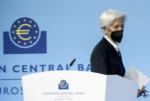The divergent performances make it challenging to talk about the G10 currencies last week. The Canadian dollar led the advancing major currencies with a 1.2% gain last week. It and the Australian dollar rose above last month's highs. On the other side was the Japanese yen. The more than 20 bp backing up of the US 10-year yield, the biggest weekly advance in two months, lifted the dollar by more than 2.8% against the yen. That is the biggest weekly gain since March 2020. For its part, the euro was little changed on the week, unable to extend its two-week 3% upside correction. The seeming lack of direction may have been partly the result of the weak ADP private sector job estimate, which proved wide of the mark. Then there was a leading US banker, who had talked
Topics:
Marc Chandler considers the following as important: 4.) Marc to Market, 4) FX Trends, Featured, newsletter, USD
This could be interesting, too:
Nachrichten Ticker - www.finanzen.ch writes Die Performance der Kryptowährungen in KW 9: Das hat sich bei Bitcoin, Ether & Co. getan
Nachrichten Ticker - www.finanzen.ch writes Wer verbirgt sich hinter der Ethereum-Technologie?
Martin Hartmann writes Eine Analyse nach den Lehren von Milton Friedman
Marc Chandler writes March 2025 Monthly
The divergent performances make it challenging to talk about the G10 currencies last week. The Canadian dollar led the advancing major currencies with a 1.2% gain last week. It and the Australian dollar rose above last month's highs. On the other side was the Japanese yen. The more than 20 bp backing up of the US 10-year yield, the biggest weekly advance in two months, lifted the dollar by more than 2.8% against the yen. That is the biggest weekly gain since March 2020. For its part, the euro was little changed on the week, unable to extend its two-week 3% upside correction.
The seeming lack of direction may have been partly the result of the weak ADP private sector job estimate, which proved wide of the mark. Then there was a leading US banker, who had talked up credit a week or so ago, came back and warned of a "hurricane" hitting the economy. Another argued that the Fed does not have the tools to fight inflation, which will stay high for years. Meanwhile, a clear consensus for 50 bp Fed hikes this month, and next has emerged.
Atlanta's Fed's Bostic idea of a pause in September never had much backing from his colleagues or the market. The September Fed funds contract moved from pricing around a 1 in 3 chance for a 50 bp rather than a 25 bp move in the last full week of May to a 2 in 3 chance now. And the bulk of the movement took place before the stronger than expected US employment report. US financial conditions have been tightening since last September, and housing and the labor market appear to be moderating but not sufficiently to give policymakers much comfort.
Dollar Index: The prospect of a hawkish ECB meeting on June 9 is coupled with narrowing the 2-year interest rate differential between the US and Germany (down more than 50 bp in the past two months to approach 2%, the least since early March). From mid-May to the start of last week, the Dollar Index fell by around 3.5%. That move looks complete. The MACD is still falling, but it is stretched. The Slow Stochastic is curling up from oversold territory. Ideally, there would be a three-legged recovery in the Dollar Index from a technical perspective. Last week, the first leg up met the (38.2%) retracement objective (of the down move since the May 13 high near 105.00). With the help of the stronger than expected US jobs report, it backed off and held the previous low (~101.30) for the second leg. The third leg will be signaled by rising above the 102.70 area, which would target the 103.15-103.60 area.
Euro: The euro's rally from a five-year low in mid-May (~$1.0350) faltered at an important technical area. The $1.0785-$1.0800 band contains retracement objectives and the downtrend line connecting the February and March highs. The MACD is overextended, while the Slow Stochastic is turning down. The $1.0600-$1.0625 band needs to hold to continue the consolidation. However, a break of that area could signal another 1-2 cent pullback. Given the momentum indicators, we would be suspicious that any move above $1.08 would be a false break.
Japanese Yen: The May PMI confirms that the Japanese economic recovery continues, and the core CPI is at its target. Yet, the BOJ has made it clear that it is not about to change its monetary policy. The rise in the US 10-year yield back toward 3.0% from around 2.70% at the end of May coincided with the dollar pushing to almost JPY130. The 20-year high set in early May was near JPY131.35, and there is little to stand in the way of a retest. The momentum indicators turned higher in late May and continue to trend up and have more scope before getting stretched. The five-day moving average crossing above the 20-day moving average for the first time since mid-May also captures the dollar's upside momentum. A break of JPY128.50-JPY129.00 would suggest a range affair rather than a trending market.
British Pound: Sterling looks vulnerable. The Slow Stochastic has rolled over from overextended territory, and the MACD looks poised to do the same. Sterling upside momentum stalled around the (50%) retracement objective of the decline from the late April high (~$1.31). The retracement target was about $1.2625. It closed above it a couple of times in late May but fell to $1.2460 in the middle of last week. The bounce from there was worth about a cent before sellers re-emerged. A break of that area sets up a test on $1.2400, which may offer more formidable support. We would be suspicious of gains above the $1.2660 area as a possible false break.
Canadian Dollar: The Canadian dollar rose over 1.1% against the US dollar last week. It was the third consecutive weekly advance, the longest since last October. The rise was the largest weekly gain of the year. The greenback posted an outside down day last Thursday, rising above the previous day's high and then settling below its low. There was a little follow through USD selling after the job report, but it was minimal, and the greenback settled higher on the day, ahead of the weekend. The MACD is still falling, but the Slow Stochastic looks poised to turn higher. The test for the US dollar bottom pickers is the CAD1.2675-CAD1.2700 area. A move above there could target CAD1.28 initially.
Australian Dollar: The Australian dollar also posted an outside up day on June 2. There was also a little follow-through ahead of the weekend that saw it briefly poked above $0.7280. However, it reversed lower and settled near session lows. The momentum indicators have turned down. Speculation of a more aggressive move by the central bank on June 7 may limit the aggressiveness of the move, but a move toward $0.7100 initially and maybe, $0.7050 seems a reasonable scenario. The swaps market has a 30 bp hike discounted, but a Bloomberg poll of economists found a median forecast for a 45 bp hike. Meanwhile, the formal decision to hike the minimum wage (5.1%) as the new government promised in the recent election is expected before the end of the month.
Mexican Peso: The dollar began the week with a drop to new two-year lows against the Mexican peso near MXN19.3150. By the middle of last week, it had bounced to around MXN19.7715. That was the first leg of what we anticipate to be a three-part dollar gain. The second part was the setback to MXN19.50 ahead of the weekend. We suspect the third part will be evident next week as the greenback trades higher. Initially, the MXN19.77 area may be targeted, and the MXN19.80-MXN19.82 may stall gains. Above there is potential toward MXN19.80-MXN19.82. The Slow Stochastic has curled up though it is still overextended. The MACD is leveling off and is near its lowest level in nearly two months.
Chinese Yuan: Chinese officials showed greater acceptance of larger yuan moves starting in April than it has for several years. The broad dollar strength and significant disruption of the Chinese economy as a consequence of the zero Covid policy weighed on the yuan, and officials did not stand in the way. Like it did more generally, the greenback pulled back from over CNY6.80 to about CNY6.6450 in about two weeks. China's onshore market was closed Friday when the dollar strengthened against the major currencies. The offshore yuan was little changed. Shanghai and Beijing are re-opening, and last month likely represented the low point. One implication is that portfolio flows may be less adverse. Consider that the Shanghai Composite, for example, rose in nine of the last 11 sessions. A new trading range may be the most likely scenario, like CNY6.60-CNY6.75.
Tags: #USD,Featured,newsletter






